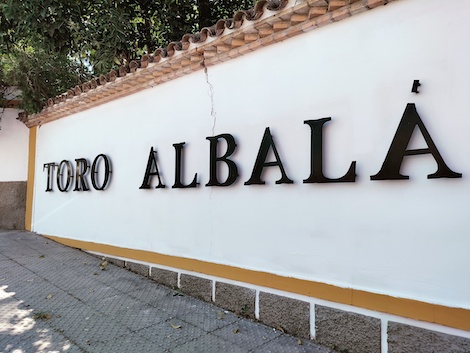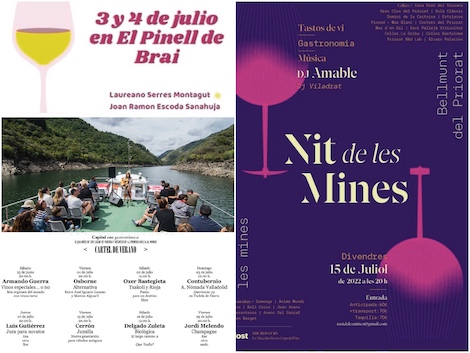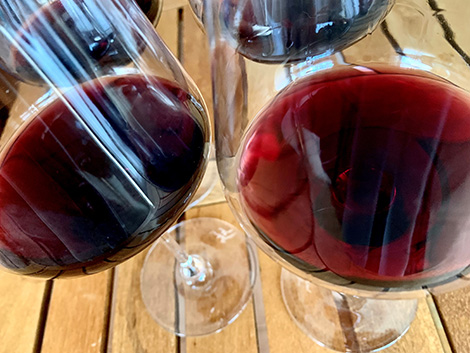100 years of Toro Albalá: changing everything so nothing changes

From his uncle José María, a jeweller by trade, Antonio Sánchez inherited not only the Toro Albalá winery, but also the craftsman's patience to recover and preserve a collection of old soleras and sweet vintage wines that are nowadays among the most iconic in Montilla-Moriles and Spain.
A tireless worker and keen collector of archaeological pieces and wine books, Sánchez is now retired from the daily business of the winery, but his imprint and perfectionism are still very much present, not only in the winemaking ethos, but also in the meticulous wine labels, some of which are handwritten and bear his printed signature.

The weight and responsibility of caring for the legacy of Antonio Sánchez, who created his very own style of Pedro Ximénez wines, now falls upon his family and two women winemakers. The handover has been in the making for some time, but the change was formalised on 27 May 2022. On that day, Toro Albalá opened the doors of its main bodega, a former power plant in Aguilar de la Frontera, to a sizeable group of importers, distributors, customers and press to celebrate its centenary.
With his trademark dark glasses and discreet demeanour, Sánchez was at the celebration but he chose to leave the limelight to the next generation. "My grandfather is a man of many friends but he likes to keep a low profile," said his grandson Antonio Muñoz Sánchez, who oversees Toro Albalá's marketing and PR and organized the celebration. Neighbouring winery owners such as Alvear, Pérez Barquero and Lagar Blanco (pictured below) also took part in the event.

Two women to oversee winemaking
The visits to the Santa Magdalena vineyard in Moriles, where Toro Albalá buys a substantial amount of fruit, and the centenary tastings in the winery —with present and past wines, described by Amaya Cervera further below— were conducted by Cristina Osuna, the current technical director with extensive experience as a consultant for small wineries in Montilla-Moriles, and winemaker Fátima Ceballos.
With her sights set on the next 100 years, Cristina is changing everything so nothing changes. Since she arrived at Toro Albalá, she has focused on tasting, sorting, moving and perfecting the arrangement of the 2,000 butts in the bodega's cellars. Her primary concern is to preserve the personality of Toro Albalá, so she has refreshed the finos to bring them back to their original character and has reclassified the amontillados and palos cortados based on their categories and qualities. She tastes, selects and works with an eye on the market and the future.
Buying old wines, as Antonio Sánchez had been doing for so many years, is increasingly difficult. Although there are occasional opportunities to get in touch with small producers who are shutting their businesses or who lack the commercial capacity to market their wines, Toro Albalá need to have his back covered more than ever. "We are starting criaderas of amontillados to make vintage wines; this is a very complex endeavour because we need to start from wines with very specific characteristics. I know I will never see them on release", Cristina points out, aware of how far ahead this bodega needs to aim for.

The second element is to make wine again. At the moment, they vinify in rented facilities, but there are plans to build their own lagar, which is expected to be operational for the 2024 harvest. The first goal is to produce enough wine to feed the criaderas of Fino Eléctrico. With virtually no vineyards of their own (they own a plot but do not make wine from it), they buy grapes from various areas in the DO in order to analyse their properties and their potential.
Osuna is a passionate champion of Moriles, an area she knows well after years of advising many small bodegas there as well as in Montilla. She is fascinated by its greater structure and complexity, although she is also aware that Moriles wines are very demanding in terms of ageing and need a lot of time. Her intention is to reserve them for long ageings and to use wines from Sierra de Montilla for shorter ageing periods. She also has her eyes set on Lucena's best terroirs, with soils that combine albariza and sand, and a style of wine that straddles the two classic quality areas.
The future at Toro Albalá lies also in still white wines. In this case, the path is guided by Fátima Ceballos, with her classical French training and passion for terroir wines, which she puts into practice in Lagar de la Salud, her small personal project making reds and whites in Montilla. In Toro-Albalá, Paco Muñoz, director and son-in-law of Antonio Sánchez, gave her free rein to do "something special with Pedro Ximénez" so she created Miut, acronym for Mimo, Identidad, Uva Tierra (Care, Land, Grape and Identity).
Change of paradigm
The centenary served as a backdrop for the presentation of this new range of still wines without a veil of yeast or flor, for which a new ageing room is being fitted out at the Aguilar de la Frontera winery. The collection, whose first vintage is 2020, includes two single vineyard whites from the two quality areas of Montilla-Moriles and a blend of both. Few bottles are produced and the prices are high in the context of similar wines locally and from the Jerez region.
This unusual boldness, especially in Andalusia, when it comes to selling wines at high prices stems not only from Toro Albalá's conviction in the quality of its wines, both young and old, but also from their international recognition, where Toro Albalá exports 60% of its production. Being specialists in vintage wines, a rarity in the world of fortified wines until very recently, has helped the company to position itself in the luxury wine segment. In fact, Don PX Convento Selección 1946, one of the vintage wines that scored 100 Parker points, is usually among the most sought-after Spanish wines on the secondary Liv-Ex market, along with Pingus and Vega Sicilia.
Paco Muñoz, with 25 years' experience working alongside his father-in-law at Toro Albalá, is convinced that the price must be driven by supply and demand. As a result, he is reorganising the bodega's stocks, both of wine and vinegar -of the 1,000 butts stored at the bodega in Moriles, 25,000 litres of vinegar are lost annually due to evaporation. "What's the point of having 5,000 butts if there's no market?," wonders Muñoz. "We have to change the paradigm and no longer focus on selling more, but rather on delivering the highest quality of our most sought-after wines and vinegars.”

With this in mind, they plan to buy new vineyards, establish more long-term contracts with growers and for each wine to have its own designated vineyard. In the future, Dos Claveles, the company's young white wine, will cease to be produced and will be replaced by Miut as an entry-level wine. For fino Eléctrico, a Toro Albalá classic, a new solera is also being created, the first bottles of which will be released in 2026. The unmistakable bulb-shaped bottle, a limited edition of Eléctrico, will not disappear but will be considerably more expensive, says Muñoz. "We have to safeguard tradition and protect this heritage, that's why we have to question everything.”
Tour and visits to the wineries in Aguilar de la Frontera and Moriles are managed by Rosario Sánchez, who is also in charge of curating the collection of more than 3,600 books exhibited in the tasting room and the archaeological material that her father has collected over the years. Immersed in the digitalisation of the library, Rosario has also given a boost to wine tourism with premium experiences that include visits to the family's archaeological museum and a chance to taste some of Toro Albalá's most exclusive wines and vinegars. "The future is looking almost as exciting for us as these first 100 years of history," remarked Rosario's husband and Toro Albalá CEO, Paco Muñoz.
Tasting very old wines
The main tasting of the centenary included six extremely old wines: two Marqués de Poley en rama, a range featuring both vintage and non-vintage wines, three single cask wines to mark the celebration and PX Excelso.
Marqués de Poley Amontillado Selección 1951. This wine is an evolution of a Fino that José María Toro Albalá used to start static ageing at the bodega. According to Cristina Osuna, grapes were mostly sourced from Sierra de Montilla in those days. At Toro Albalá, vintage Amontillados and Palos Cortados are labelled with the date that the oxidative ageing process began. Meanwhile, sweet PX wines are categorized by the vintage.
With an intense mahogany colour, the nose is rich with nutty, pastry and brandy aromas as well as roasted tar-like notes. Powerful and concentrated on the palate, it combines bitter chocolate with salted almond flavours. The finish is very long and salty with notes of pistachio. Sold for €160 to €175. 21% abv.
Marqués de Poley Palo Cortado Selección 1964. This unfortified wine naturally reached 22% abv. due to the concentration that takes place during the ageing process. Grapes were originally sourced from Moriles Altos. Palo Cortado is a rarity in Montilla. In fact, Antonio Sánchez wasn’t particularly fond of it, but he decided to keep the butts that developed this style because he was keen to witness their evolution. They were stored in the so-called aerial cellar (see slider), two rows of butts resting close to the roof of the library that is used as tasting room. He developed an ingenious filling system following the "communicating vessels" principle although it is no longer in use —as new vintages are added, they are kept separate from each other. This decision means that topping up the barrels is now more complicated as it has to be done by hand with the help of a long ladder.
Poley Palo Cortado 1964 shows tremendous concentration. It starts with acetaldehyde and old furniture notes developing into sweet spices (cinnamon) and nutty aromas. The palate confirms these sensations: sharper and more powerful than the Amontillado, vibrant acidity as a result of the concentration process that occurs over time, and a very long finish. Tasted side by side, the two styles are clearly defined. A real ying-yang duel.
Palo Cortado Centenario Single Cask. The Single Cask range is a very specific selection of butts, one for each style of wine, to mark the 100th anniversary —there are barely 300 bottles of each wine. The exact age is unknown. The Palo Cortado, which could be 60-70 years old, sits well above Poley 1964 in terms of concentration although it has the same alcohol content (22% abv.). It swings between its comforting warmth —a sort of spirits-like heat feeling in the pit of your stomach), and the sharp, almost achy concentration derived from a very long time ageing in oak. The finish is distinctly salty. A beast of a wine, certainly not for everyone.
Amontillado Centenario Single Cask. This amontillado, made from wines originally sourced from Moriles Altos, captures the essence of the finest qualities that the region has to offer. It’s high in alcohol (22% vol.) but it is tremendously complex (carpentry, toasted aromas, hazelnuts, old furniture) and elegant. The wine starts smoothly on the palate and brightens up thanks to its lively acidity. But the best thing is the enveloping, never-ending finish that takes your senses to a cloud of creamy nuttiness. It was our favourite wine of the tasting.
Don PX Centenario Single Cask. In line with Toro Albalá’s distinctive old PX style, perhaps a little less spiced, but complex, not too concentrated and offset by the sharpness that comes from its extended aging. A finely textured, complex wine with a symphony of aromas ranging from raisins and dark chocolate to toffee, coffee beans and crème brûlée. Sugar in these wines can exceed 400 g/l.
Don PX Excelso. This extremely old PX is a tribute to the incredible amount of work involved in extended ageing. In the case of sweet PX, this includes wine losses and frequent cask reconditioning. This is also one of the first old wines to carry Cristina's signature. As opposed to the finesse of the previous wine, there is far more concentration here. Darker and more syrupy, with a strong raisin character, coffee grounds and bitter chocolate with a hint of volatile acidity adding some freshness. Best enjoyed in small sips.

The white wines
Miut El Jabonero 2020 comes from a hundred-year-old vineyard at 520m elevation in Sierra de Montilla on solid chalky soils called tosca cerrada. Most of the wine is fermented in 500-litre French oak barrels and a small portion in amphorae and it is later aged on its lees for 10 months. The chalky character emerges strongly over the oak leading to a sapid finish. Fewer than 4,000 bottles produced. 14% abv. Around €43 in Spain.
Grapes for Miut Santa Magdalena 2020 are sourced from Moriles Altos. Elevation is lower and so is the temperature variation between day and night. Chalk is laminated in this vineyard (tosca hojaldrada is the local name for it). Winemaking follows the same pattern, except that no amphorae were used here, although they have introduced them in the 2021 vintage. The wine is riper and unctuous, with dried apricots and stone fruit aromas. The oak is more obvious, so it will need some time to integrate it. Only 1,180 were produced and, surprisingly enough, the alcohol remains at 13% vol. It costs around €38.
Miut Assemblage 2020 is the result of blending batches of the two previous wines just after fermentation. Ageing takes place in stainless steel tanks. On the nose, you get the ripe fruit aromas of Moriles, but the palate is brightened up by the salty notes of El Jabonero. This is perhaps the right choice for anyone wanting to try this new style of whites in Montilla-Moriles. 1,225 bottles produced and sold for €27 each.
Starting in the 2021 vintage, Toro Albalá launched a new project in Bierzo. It is managed by Fátima Ceballos and there are no release dates yet. In this initial approach, they have sought out vineyards in various locations across the DO in order to learn about different terroirs, but prioritising late-ripening areas with a northern aspect. Wines from five areas — Corullón, Cacabelos and various hamlets near Ponferrada, each with their own traceability— are ageing in a rented space in a local cellar.
Destemmed grapes were left to ferment with little extraction in stainless steel tanks; the wines are later aged for a year in mostly 500-litre oak barrels. The wines are due to be bottled in January 2023 — at that point, they will also decide the range of wines that will eventually be released.

Yolanda Ortiz de Arri
A journalist with over 25 years' experience in national and international media. WSET3, wine educator and translator

Amaya Cervera
A wine journalist with almost 30 years' experience, she is the founder of the award-winning Spanish Wine Lover website. In 2023, she won the National Gastronomy Award for Gastronomic Communication
NEWSLETTER
Join our community of Spanish wine lovers






